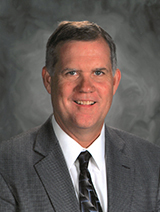President’s Perspective: Meeting Principals’ Needs—Nationwide
By Mark J. White Communicator April 2015, Volume 38, Issue 8
 By Mark J. White
By Mark J. White
Communicator
April 2015, Volume 38, Issue 8
One of the many lessons I have learned this year while traveling and representing NAESP is that each state association is quite different and unique, with varying interests and needs. Consider, for example, that membership in state associations varies widely: Some have over 5,000 members, while others have fewer than 100. This trend continues in membership by state in NAESP, with some states running as high as 1,400, and others as few as 50 or less. You might also be interested to know that in some states, elementary and secondary principals comprise their own separate associations; in others, all principals are in the same association; and still, in others, all administrators in the state, including superintendents, are in the same association. In about half the states, when principals join their state association they also must join NAESP and vice versa, and in other states principals make a choice to join either or both the state association and NAESP.
All of this detail helps to emphasize that NAESP must meet a wide range of needs from state associations and members, as well as address varied perspectives about meeting those needs. As a principal and a state leader, I had no idea of the distinctive ways state associations are organized and connected to NAESP. However, over the past 5 years that I have served as a member of the NAESP Board of Directors, including this year as NAESP President, I have developed a much clearer picture of the unique position NAESP is in. NAESP seeks to strengthen relationships with states, which is a responsibility that it doesn’t take lightly.
Next Steps
The future of education in this nation is currently at a critical juncture. To name just a few drivers, the accountability movement is changing much about what is deemed important and how schools operate. Technology is exploding as we navigate its instructional potential. And social media is changing how we communicate with each other.
To keep pace with all of these changes, this past October the NAESP Board adopted a new Strategic Growth Plan. That plan, combined with the recent Bylaws changes, is shaping NAESP’s movement forward on behalf of elementary and middle school principals. The NAESP Board made the bold decision this past fall to direct the Association to take a much more collaborative approach to working with our fellow secondary principals at the National Association of Secondary School Principals (NASSP). The NAESP Board reaffirmed its commitment to maintaining NAESP’s separate identity and governance to ensure a continued strong voice on behalf of elementary and middle-level principals. However, the NAESP Board believes that by working together with NASSP, we can leverage the intellectual and capital resources of both of our associations to support not only principals and the children they serve, but also state associations.
One of the barriers to that collaboration has been the 25 mile physical distance between NAESP’s Samuel G. Sava building in Alexandria, Virginia, and NASSP’s office in Reston, Virginia. To facilitate better collaboration, the majority of the NAESP staff has moved to a section of NASSP’s building in Reston, which is located on a beautiful campus near the new Silver Line metro stop. NAESP has retained the second floor of the current Samuel G. Sava building in Alexandria to house a portion of the staff and to potentially house a professional development training site. We will be leasing out space to other likeminded educational organizations on the rest of the floor. AASA, The School Superintendents Association, now owns the first and third floors of the Alexandria building. NAESP is now in the unique position of being located in two spaces, enhancing our relationship with both the secondary principals association and the school superintendents association. At some point in the near future, the mailing address for NAESP will change with the move.
This move has been met with a variety of responses from state associations and state leaders, sometimes influenced by how they are organized and what their relationship is with their secondary colleagues. We have done our best to respect the variety of opinions expressed, noting concerns and addressing them. We welcome all feedback and viewpoints and will consider them as a part of future discussions and decisions.
I am confident the membership will continue to elect thoughtful principals to represent them on the NAESP Board—leaders who will make decisions in the best interest of the membership and elementary and middle school principals in this great country. The NAESP Board took this bold step to ensure that elementary and middle-level principals continue to have access to the best resources and to enhance our collaborative efforts on behalf of the children we serve. We believe this can be done while retaining NAESP’s identity and unique support for elementary and middle-level principals.
Mark J. White is president of NAESP and principal of Hintgen Elementary School in La Crosse, Wisconsin.
—
Copyright © 2015. National Association of Elementary School Principals. No part of the articles in NAESP magazines, newsletters, or website may be reproduced in any medium without the permission of the National Association of Elementary School Principals. For more information, view NAESP’s reprint policy


